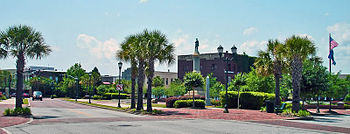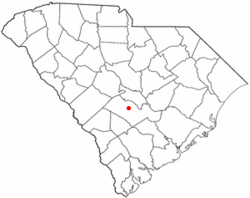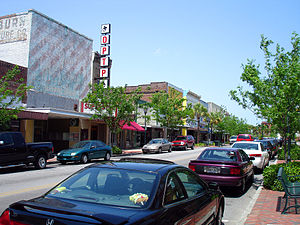- Orangeburg, South Carolina
-
Orangeburg, South Carolina — City — Downtown Orangeburg Nickname(s): The Garden City Location in Orangeburg County, South Carolina Coordinates: 33°29′49″N 80°51′44″W / 33.49694°N 80.86222°WCoordinates: 33°29′49″N 80°51′44″W / 33.49694°N 80.86222°W Country United States State South Carolina County Orangeburg Government – Mayor Paul Miller Area – Total 8.3 sq mi (21.5 km2) – Land 8.3 sq mi (21.47 km2) – Water 0.0 sq mi (0.02 km2) Elevation 243 ft (74.676 m) Population (2000) – Total 12,765 – Density 623.4/sq mi (240.7/km2) Time zone EST (UTC-5) – Summer (DST) EDT (UTC-4) ZIP codes 29115-29118 Area code(s) 803 FIPS code 45-53080[1] GNIS feature ID 1249990[2] Website www.orangeburg.sc.us Orangeburg, also known as "The Garden City," is the principal city and county seat of Orangeburg County, South Carolina, United States.[3] The city is also the fifth oldest city in the state of South Carolina. The city population was 13,964 at the 2010 census [4] within a Greater Orangeburg population of 67,326.[5] The city is located 37 miles southeast of Columbia, on the north fork of the Edisto River.
In May 2000, the city created the Orangeburg County Community of Character initiative, which is a collaborative effort by the Downtown Orangeburg Revitalization Association (DORA), The Times and Democrat newspaper, the Orangeburg County Chamber of Commerce, and the Orangeburg County Development Commission.
In 2005, the National Civic League awarded Orangeburg County with the coveted All-America City Award (which can be awarded to either a city or a county), which recognizes and encourages civic excellence and honors communities in which citizens, government, businesses, and non-profit organizations demonstrate successful resolution of critical community issues.
In 2007, Orangeburg hosted the first 2007 Democratic U.S. presidential candidate debate at Martin Luther King Jr. Auditorium on the campus of South Carolina State University.
Contents
History
Orangeburg, named for William IV, Prince of Orange, the son-in-law of King George II, of England[citation needed], was first settled in 1704 by an Indian trader, George Sterling.
To encourage settlement, the General Assembly of the Province of South Carolina in 1730 made the area into a township in the shape of a parallelogram 15 x 5 miles (8.0 km). In 1735, a colony of 200 Swiss, German and Dutch immigrants formed a community near the banks of the North Edisto River. The site was attractive because of the fertile soil and the abundance of wildlife. The river provided an outlet to the port of Charleston for the agriculture and lumber products. The town soon became a well-established and successful colony, composed chiefly of small farmers.
The church played an important role in the early life of Orangeburg. The first church was a Lutheran congregation but later became an Anglican Church, as the colonial legislature recognized the Anglican church as the official government-sponsored church, thereby exempting it from taxation. The church building was erected prior to 1763 in the center of the village and was destroyed at the time of the Revolutionary War. A subsequent church building was used as a smallpox hospital by General William Tecumseh Sherman during the Civil War.
The center of the original village was near what is now Broughton and Henley Streets, according to a marker there.
In the 1960s Orangeburg was a major center of Civil Rights Movement activity involving students from both Claflin College and South Carolina State College and residents of Orangeburg's Black community. When economic retaliation was used against local Blacks seeking school integration in 1956, students came to their support with hunger strikes, boycotts, and mass marches. In 1960, over 400 students were arrested on sit-ins and integration marches organized by CORE. In August 1963, the Orangeburg Freedom Movement (OFM) chaired by Dr. Harlowe Caldwell of the NAACP, submitted 10 pro-integration demands to the Orangeburg Mayor and City Council. After negotiations failed, mass demonstrations similar to those that occurred in Birmingham resulted in more than 1,300 arrests. On February 8, 1968, after days of protests against a segregated bowling alley, violence broke out on the South Carolina State campus,(actually by bowling alley not school grounds) between police and Black students. Police opened fire on a crowd of students, killing Samuel Hammond, Henry Smith, and Delano Middleton, and wounding 27 others in what became known as the "Orangeburg Massacre".[6]
Geography
Orangeburg is located at 33°29′49″N 80°51′44″W / 33.49694°N 80.86222°W (33.496843, -80.862206)[7].
According to the United States Census Bureau, the city has a total area of 8.3 square miles (21.5 km²), of which, 8.3 square miles (21.5 km²) of it is land and 0.12% is water.
Infrastructure
Municipal government
The city operates under the council form of government. The governing body is composed of a mayor and six members. The mayor is determined through a nonpartisan, at-large election for a four-year term of office while Council Members are chosen through nonpartisan, single-member district elections. Council members are elected to staggered four-year terms of office.
City council is a legislative body, establishing policies with recommendations from the city administrator. The city administrator acts as the chief administrator of the council's policies implemented through the administrative control of city departments given to him by ordinance.
Mayor: Paul Miller
Council Members
•Richard F. Stroman
•Charles W. Jernigan
•Charles B. Barnwell, Jr.
•Bernard Haire (Mayor Pro Tem)
•Charles B. Barnwell, Jr.
•Sandra P. KnottsState Senators
•Brad Hutto
•John MatthewsEducation
Colleges and universities
- Claflin University, founded in 1869, is the oldest historically Black institution in the state of South Carolina. U.S. News and World Report, in its 2006 Guidebook to American Colleges and Universities, ranked Claflin in the "Top Ten" and rated the university number one in the "Best Value" category among comprehensive colleges in the South for students pursuing bachelor's degrees. Claflin is an independent, four year, co-educational, residential, career-oriented liberal arts university affiliated with the United Methodist Church. Over 1,800 students are enrolled from 24 states and 19 foreign countries.
- South Carolina State University is 4-year public historically Black institution in Orangeburg, SC. Founded in 1896, the university is consistently among the national leaders in producing black students with baccalaureate degrees in biology, education, business, engineering technology, computer science/mathematics, and English language/literature. South Carolina State University offers a number of programs in South Carolina and the nation, including the only undergraduate nuclear engineering program in the state and the only masters of science degree in transportation in the state. Also, in 1998 the school was named by the U.S. Congress and the USDOT as one of 33 University Transportation Centers in the nation, the only one in South Carolina.
- Southern Methodist College[2] was established by the Southern Methodist Church as a Bible college to provide a distinctively Christian post-secondary education committed to the ideals, the doctrinal convictions, and the ethical practices of the sponsoring denomination. The Southern Methodist Church, formed in Columbia, South Carolina, on January 14, 1939, as the continuing body of the Methodist Episcopal Church, South, later established Southern Methodist College as an institution of the Church on January 26, 1956 in Greenville, moving to Aiken in 1958 and again to Orangeburg in 1961.
- Orangeburg-Calhoun Technical College is a member of the American Association of Community Colleges and is accredited by the Commission on Colleges of the Southern Association of Colleges and Schools (SACS) to award Associate in Arts, Associate in Science and Associate in Applied Science degrees. It is a comprehensive two-year technical college that provides training of persons for jobs in new and expanding industries, upgrading programs for workers already employed and university transfer opportunities.
Private schools
- Orangeburg Preparatory Schools, Inc.
- Wesley Christian School
- Orangeburg Christian Academy
Public schools
- Orangeburg Consolidated School District Three
- Orangeburg Consolidated School District Four
- Orangeburg Consolidated School District Five
Transportation
People and culture
Demographics
As of the census[1] of 2000, there were 12,765 people, 4,512 households, and 2,526 families residing in the city. The population density was 1,539.0 people per square mile (594.5/km²). There were 5,168 housing units at an average density of 623.1 per square mile (240.7/km²). The racial makeup of the city was 67.51% African American, 29.78% White, 0.13% Native American, 1.14% Asian, 0.04% Pacific Islander, 0.79% from other races, and 0.61% from two or more races. Hispanic or Latino of any race were 1.29% of the population.
There were 4,512 households out of which 23.8% had children under the age of 18 living with them, 33.5% were married couples living together, 18.8% had a female householder with no husband present, and 44.0% were non-families. 35.2% of all households were made up of individuals and 13.1% had someone living alone who was 65 years of age or older. The average household size was 2.23 and the average family size was 2.88.
In the city the population was spread out with 17.7% under the age of 18, 28.6% from 18 to 24, 21.0% from 25 to 44, 17.5% from 45 to 64, and 15.2% who were 65 years of age or older. The median age was 28 years. For every 100 females there were 76.2 males. For every 100 females age 18 and over, there were 71.0 males.
The median income for a household in the city was $30,306, and the median income for a family was $37,008. Males had a median income of $30,310 versus $21,935 for females. The per capita income for the city was $15,263. About 17.9% of families and 24.7% of the population were below the poverty line, including 34.7% of those under age 18 and 14.8% of those age 65 or over.
Crime
The following table shows Orangeburg's crime rate in 6 crimes that Morgan Quitno uses in their calculations for "America's most dangerous cities" rankings, in comparison to 100,000 people. The statistics provided are not for the actual number of crimes committed, but for the number of crimes committed per capita.[8]
Crime Orangeburg, SC (2009) per 100,000 people Murder 1 7.5 Rape 9 67.8 Robbery 34 256.1 Assault 35 263.6 Burglary 232 1747.3 Automobile Theft 65 489.5 Arson 2 15.1 Events and attractions
The Edisto Memorial Gardens displays past and current award winning roses from the All-American Rose Selections. Some 4,000 plants representing at least 75 labeled varieties of roses are always on display in the Gardens. The site was first developed in the 1920s with some azaleas on 5 acres (20,000 m2) of land. A playground was added in 1922, and a greenhouse and nursery facility in 1947. To extend the season of beauty, the first rose garden was planted in 1951. Currently, there are more than 50 beds of roses ranging from miniatures from grandiflora to climbers on over 150 acres (0.61 km2) of land.
The IP Stanback Museum & Planetarium, named for the first African-American chairman of the University's Board of Trustees, Israel Pinkney Stanback, had its origin in the basement of the then South Carolina State College's library in the early 1970s. The Museum and Planetarium is located on the campus of South Carolina State University and signifies their commitment to community service. The Museum's exhibition area is one of the largest in the state. Its forty-foot planetarium dome, located across the foyer adjacent to the galleries, has an auditorium capacity of eighty-two seats and a Minolta IIB Planetarium Projector. The building is easily accessible to the handicapped and is a uniquely adaptable facility, capable of hosting many different types of presentations.
The Orangeburg Festival of Roses began as a vision held by a group of citizens seeking a way to enhance the development of Orangeburg and improve the quality of life for its residents. As a result of that vision, the first festival was held in 1972. The Greater Orangeburg Chamber of Commerce was the sole sponsor of that first festival. At present the City of Orangeburg and the Orangeburg County Chamber of Commerce are co-sponsors of the event. The festival includes such events as a river race, a basscatcher tournament, the Princess of Roses pageant, and various sports tournaments.
During the winter in Orangeburg, more festivities get under way when raccoon hunters from throughout the Southeast gather for the Grand American Coon Hunt. Also on the "Top Twenty" list, the hunt, which takes place each year in early January, in the largest field trial for coon dogs in the United States and is a qualifying event for the World Coon Hunt. Thousands of people come to the fairgrounds to see the dogs, exhibits and the sights and sounds of this one of a kind event.
Media
The Times and Democrat serves as the daily newspaper for the Orangeburg area.
Notable natives and residents
- Alex Barron: Florida State Tackle. Drafted by the St. Louis Rams 19th overall in the 2005 NFL Draft.
- Shelton Benjamin: Professional wrestler and former amateur wrestler who notably worked for World Wrestling Entertainment. Born in Orangeburg on June 23, 1977.
- Gloria Blackwell: educator and civil rights activist
- Stephen Euin Cobb: (author, futurist and host of the award winning podcast The Future and You) Born in Orangeburg S.C. on February 3, 1955.
- Monique Coleman: Actress and singer, most notably from High School Musical and High School Musical 2.
- Shawnee Smith: Actress and musician. Well known for her roles as Amanda Young in Saw I-VI and Linda in the TV series Becker. She is also the other half of the country-rock band Smith & Pyle alongside actress Missi Pyle. Born in Orangeburg, SC on July 3, 1970.
- Donnie Abraham: Football player for East Tennessee State University, Tampa Bay Buccaneers, New York Jets.
- Angell Conwell: Actress, born in Orangeburg, SC on August 2, 1983.
- Bob Corker: U.S. senator from Tennessee, born in Orangeburg on August 24, 1952.
- Don Covay: Musician, born in Orangeburg on March 24, 1938.
- Woodrow Dantzler: Clemson University quarterback and AFL player. First player in NCAA history to pass for more than 2,000 yards (1,800 m) and rush for more than 1,000 yards (910 m) in a single season.
- Ralph B. Everett: President and CEO of the Washington, D.C.-based Joint Center for Political and Economic Studies (website), the nation's premier African American think tank. Born in Orangeburg, SC on June 23, 1951.
- Nikki Haley, from neighboring Bamberg County, educated at Orangeberg Preparatory and SC's 1st female and minority governor.
- Israel Hicks (1943–2010), stage director who presented August Wilson's entire 10-play Pittsburgh Cycle.[9]
- Tim Jennings: University of Georgia cornerback. Drafted by the Indianapolis Colts in the 2nd round of the 2006 NFL Draft.
- Mikki Moore: Professional basketball player who is currently a free agent and has played for a total of 9 teams.
- Eugene Robinson: Op-Ed columnist, The Washington Post, born in Orangeburg in 1955.
- Steve Sonic: Musician, founder of seminal punk band Red Menace and member of punk band Bored Suburban Youth.
- Bill Spiers: Major League Baseball player for the Milwaukee Brewers, New York Mets, and the Houston Astros.
- Karen J. Williams: former Chief Judge of the United States Court of Appeals for the Fourth Circuit, born in Orangeburg in 1951.
- Herm Winningham: retired Major League Baseball player and World Series Champion (1990).
- Dwayne Harper: former professional American football cornerback who played 12 seasons in the National Football League
References
- ^ a b "American FactFinder". United States Census Bureau. http://factfinder.census.gov. Retrieved 2008-01-31.
- ^ "US Board on Geographic Names". United States Geological Survey. 2007-10-25. http://geonames.usgs.gov. Retrieved 2008-01-31.
- ^ "Find a County". National Association of Counties. http://www.naco.org/Counties/Pages/FindACounty.aspx. Retrieved 2011-06-07.
- ^ http://factfinder.census.gov/servlet/SAFFPopulation?_event=ChangeGeoContext&geo_id=16000US4553080&_geoContext=&_street=&_county=orangeburg%2C+sc&_cityTown=orangeburg%2C+sc&_state=&_zip=&_lang=en&_sse=on&ActiveGeoDiv=&_useEV=&pctxt=fph&pgsl=010&_submenuId=population_0&ds_name=null&_ci_nbr=null&qr_name=null®=null%3Anull&_keyword=&_industry=
- ^ [1], Orangeburg County Chamber of Commerce
- ^ Civil Rights Movement Veterans ~ History & Timeline
- ^ "US Gazetteer files: 2010, 2000, and 1990". United States Census Bureau. 2011-02-12. http://www.census.gov/geo/www/gazetteer/gazette.html. Retrieved 2011-04-23.
- ^ http://www.city-data.com/city/Orangeburg-South-Carolina.html
- ^ Weber, Bruce. "Israel Hicks, Director of August Wilson’s Cycle, Dies at 66", The New York Times, July 7, 2010. Accessed July 8, 2010.
External links
- City website
- City Department of Public Safety
- County website
- Orangeburg County Chamber of Commerce
- Orangeburg County Development Commission
- Orangeburg County Community of Character
- Downtown Orangeburg Revitalization Association
Municipalities and communities of Orangeburg County, South Carolina City Orangeburg
Towns Bowman | Branchville | Cope | Cordova | Elloree | Eutawville | Holly Hill | Livingston | Neeses | North | Norway | Rowesville | Santee | Springfield | Vance | Woodford
CDPs Unincorporated
communitiesProvidence | Sixty Six | Wells
 State of South Carolina
State of South CarolinaRegions Larger cities Smaller cities Towns CDPs Counties - Abbeville
- Aiken
- Allendale
- Anderson
- Bamberg
- Barnwell
- Beaufort
- Berkeley
- Calhoun
- Charleston
- Cherokee
- Chester
- Chesterfield
- Clarendon
- Colleton
- Darlington
- Dillon
- Dorchester
- Edgefield
- Fairfield
- Florence
- Georgetown
- Greenville
- Greenwood
- Hampton
- Horry
- Jasper
- Kershaw
- Lancaster
- Laurens
- Lee
- Lexington
- Marion
- Marlboro
- McCormick
- Newberry
- Oconee
- Orangeburg
- Pickens
- Richland
- Saluda
- Spartanburg
- Sumter
- Union
- Williamsburg
- York
Topics - History
- Famous people
- Governors
- Legislature
- State House
- Congressional districts
- Census areas
- State parks
- Rivers
- Wildlife refuges
- Historic places
- Amusement parks
- Colleges and universities
- Sports venues
- Shopping malls
- Television stations
- Radio stations
- Highways
- Airports
- Visitor attractions
Categories:- Cities in South Carolina
- Orangeburg County, South Carolina
- County seats in South Carolina
- Populated places in South Carolina with African American majority populations
Wikimedia Foundation. 2010.





